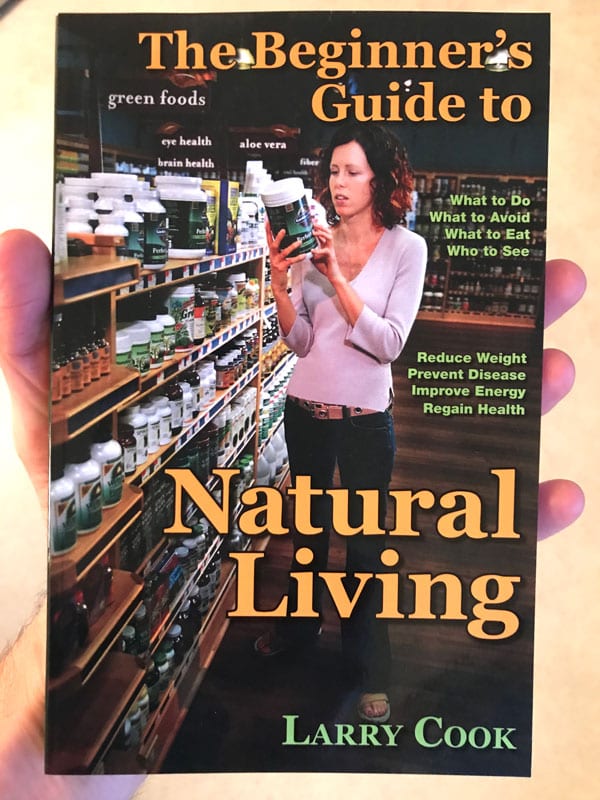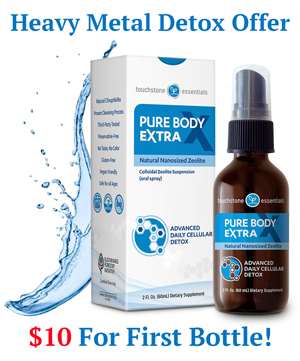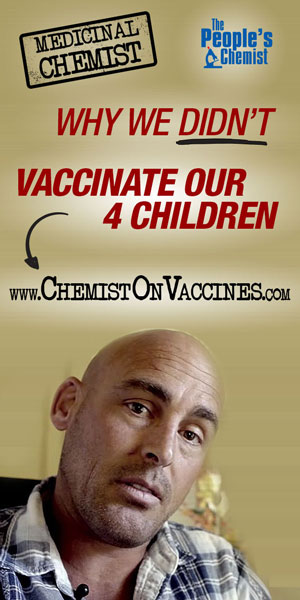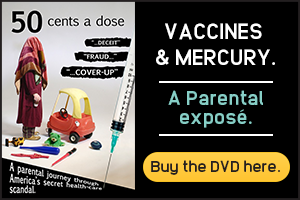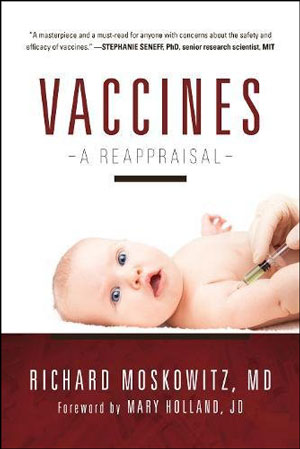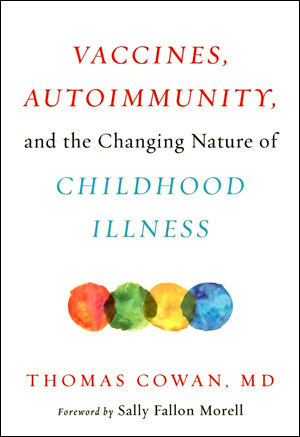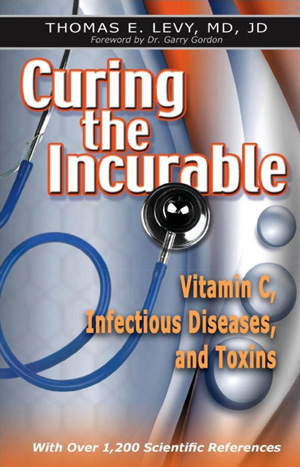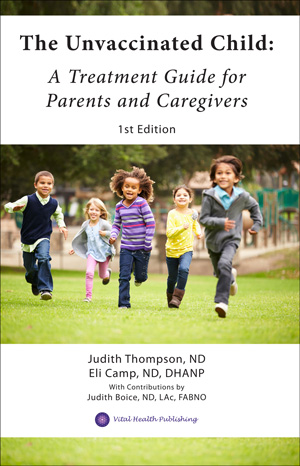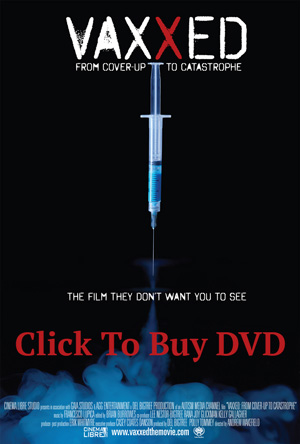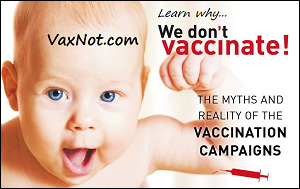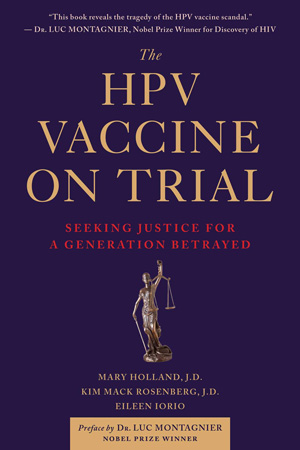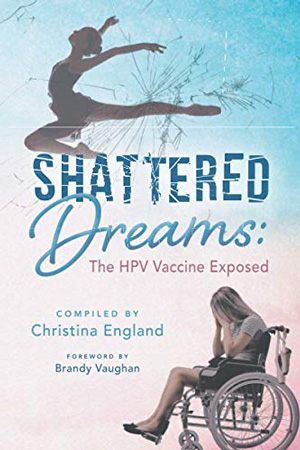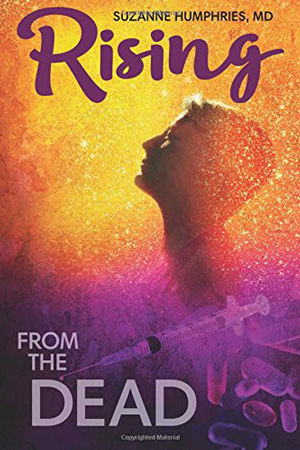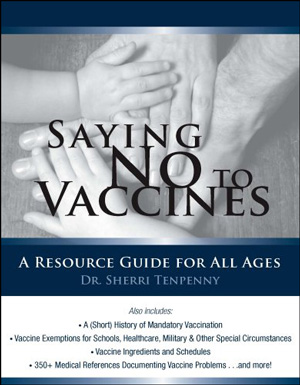How To Go Vaccine Free
The health of your entire family unit, and everything you do to keep everyone healthy, is your best defense against an infection that could turn catastrophic (which can happen with or without vaccination). In short, what you want to do is adopt a natural lifestyle, one where toxic exposure inside and outside of the home is severely limited, while nutrition uptake is maximized, and natural healing remedies are used as a first line of defense against any potential infections and health issues.
I wrote an entire book about how to live a natural lifestyle, called The Beginner’s Guide to Natural Living, and I highly recommend it for every parent who is not fully immersed in the natural living lifestyle. In short, you want to avoid all chemical and GMO foods, eat whole organic food, remove any and all toxic cleaning supplies and use only nontoxic cleaning supplies – especially laundry detergent – and really dive into this topic so that you, your family and your children are living as naturally as possible.
Adopting a natural lifestyle does not, necessarily, prevent infection, but, it does create a very healthy environment and body that can more easily resist infections, or, if infection occurs, the body can more easily recover from that infection, which helps to build immunity to future such infections.
Here are some notes about the importance of creating a healthy family unit…
The goal is not to prevent infection, per se, but to prepare for it by building healthy immune function/healthy body
- Infection can be prevented, but we don’t want to do this through the use of synthetic or natural “biocidins” / natural antibiotics or antivirals. We want to use proper / potent nutrition (through DIET first, not supplements – supplements are not supposed to replace a proper, nutrient-dense diet, but to “supplement” it) and good hygiene, quality drinking water (mineral content, especially magnesium and silica is very important).
- Infection can be highly beneficial. Symptoms are unpleasant but the purpose of infection is positive. Removal of mucus is one of the main goals of infection. The body is trying to remove unwanted waste, toxicity, etc. https://www.ncbi.nlm.nih.gov/pmc/articles/PMC4048736/
- Fever is important for the immune system to work more efficiently. When a fever “breaks” and an individual sweats, this is another mechanism by which the immune system removes metals and other toxics – through sweat. https://www.ncbi.nlm.nih.gov/pubmed/22505948
- Most of the illnesses we vaccinate against have only a human reservoir. We have been living symbiotically with these microorganisms for a very long time. The so-called “childhood diseases” typically appear between ages 3-5 years, and are usually past by the time of puberty. This age of onset typically coincides with when the antibodies from the mother wear off, and when the child’s own immune system is finally fully functional.
Homeoprophylaxis – The Original “Vaccine”
Homeoprophylaxis is a Homeopathic preparation that causes the immune system to learn about potential infection by understanding an energetic imprint of that potential infection. Thus, a measles virus, for example, is diluted to such a degree (called “succession”) that all that is left is an energy imprint, and when taken orally, that energy imprint helps the immune system recognize the “real thing” if ever exposed and can therefore mount a defense much faster than had Homeoprophylaxis not been used.
Homeoprophylaxis originated in 1799 with the founder of homeopathy Samuel Hahnemann. His community was facing a scarlet fever epidemic and he decided to look at how the disease itself expressed itself, and looked at the symptom picture to find a homeopathic remedy that would produce the same symptom picture. And he came to the remedy called belladonna, which is deadly nightshade.
He went and visited homes where a child in the family was sick and then gave the remedy to other members of the family who had not yet become ill in order to prevent them from getting sick. He was very pleasantly surprised to find that it was very effective and that these children were not getting ill.
Since Hahnemann’s time two methods for Homeoprophylaxis have been developed. One is as Hahnemann did, where you take the genus epidemicus. That means you take the state of the illness, how it’s presenting at the time in the majority of people to understand its symptom picture and then you match that to a homeopathic remedy as Hahnemann did with belladonna.
The second way to use homeoprophylaxis is through the development of nosodes. Nosodes are homeopathic remedies prepared from pathogens such as a virus or a bacteria or a fungus. More recently this has become more en vogue in its use, but it’s been around since the time of smallpox, where it used smallpox homeopathically to see if it could prevent the illness.
In 1907 a doctor by the name of Charles Eaton actually decided to do his own small study to see how effective it was. He found that it had a close to 98 percent success rate in preventing smallpox. He actually compared the number of people that received the prophylaxis and how many of those people were definitely exposed to smallpox at the time and then how many of those people who had the exposure had gotten ill. It was a very small number of people. That’s where the history of homeoprophylaxis began.
Homeoprophylaxis was used in the late 19thcentury and early 20thcentury with great success in reducing death rate and disease transmission. Unfortunately, Pharma came along and was able to get Congress to effectively shutter hundreds of thriving Homeopathic schools to make way for allopathic medicine, and their highly toxic vaccines.
One of the most essential reasons to receive homeoprophylaxis is to boost and activate the immune system, and improve the immunity through a safe delivery mechanism. Hp has also been recognized to lessen vaccine injury and adverse reactions to vaccination. No side effects. No needles. No toxins. No vaccine-injury or death. Click here to learn more about Homeoprophylaxis, and click here to locate a homeopathic practitioner certified in homeoprophylaxis. You can also take this Children’s Homeoprophylaxis Program and Online Course.
Your Child’s Birth
As one midwife once said, birthing a child is not an emergency, but rather it is an emergence. A well-planned birth process can help ensure a healthy birth with fewer possibilities for complications and most importantly, a bully-free birth that does not include your repeated denials of vaccines and other unnecessary medical procedures.
Although there are many components to having a successful birth, one of the most important components of all is to be stress free during the birthing process.
Home Birth, Birthing Center or Hospital?
Scheduling a birth at a hospital is almost for sure asking for trouble. Not only are hospitals in a hurry to get the baby out (leading to fake reasons to get a caesarian section) and the use of drugs that can cause side-effects, but hospitals love to bully parents to use eye goop (antibiotic ointment), get the vitamin K shot (supposedly to prevent brain bleed) and get the HepB vaccine, all of which are not only unnecessary, but also dangerous. The very real risk of refusing hospital demanded treatment is a call to Child Protective Services or outright medical kidnap for refusal. And if you have other children, the State may confiscate them too.
A safer way to give birth is to do a home birth, or give birth at a birthing center. The major advantage of a home birth is the ability to relax in your own environment, and relaxation is key to a successful birth. Of course, you will not need to deal with bully doctors, nurses and hospital staff either, which is a major bonus. That said, you should have a hospital selected as a back-up should that be required.
Find A Midwife
No matter where you decide to have your child, you will want to work with a knowledgeable midwife throughout your pregnancy and through your birth, preferably one who is vaccine aware and does not encourage vaccination. If you must go to the hospital, a good midwife will be there with you to fight the bullying and harassment that often comes from the hospital. Midwives are specially trained not only to help with pre-natal nutrition and the birth process, but what to do should a concern arise that may require more advanced medical intervention.
The facts of birth clearly state that not only are most healthy women quite capable of natural, spontaneous labor and delivery, but that the hormones secreted during an intervention-free labor and delivery provide pain relief, engender feelings of love and connection with the birthing baby, facilitate communication between the physiology of baby and mother, and can assist women in achieving a transcendent, empowered state. Midwives are experts at preparing women for this type of experience, and their main function, ideally, is simply to support the woman and allow the birth to happen. They guard the process, monitoring the baby’s heart rate and keeping the parents informed of their options if any complications arise.
Most, if not all, midwives have a working relationship with one or more obstetricians and are prepared to transport a birthing mother to a hospital if it becomes medically advisable and necessary. However, most birth complications can be anticipated, and because of the empowered rather than fear-based foundation of their training, midwives are able handle many situations that would be considered complications in a conventional medical setting.
Create A Birth Plan
The best way to have a birth is to have a prepared birth plan that you have given to your doctor and anyone else involved to ensure everyone is 100% on board with your plan. By creating this in advance you have a better chance of not being bullied if you wind up in a potential moment of weakness, so that your advocates – including your midwife – have exact instructions on your wishes. This could include no eye goop, no vitamin K shot, no HepB vaccine, and a multitude of other requirements. Your midwife can help you put this together.
Hormones and the Sexuality of Birth
There are four important hormones secreted during an undisturbed labor and delivery that play a major role in allowing the natural process to unfold. They originate in the middle brain, which is the primitive (non-thinking) as opposed to the rational (thinking) part of the brain. It is crucial, therefore, that a birthing mother be in an atmosphere where she feels completely safe and relaxed in order to allow this part of the brain to take over. In a more relaxed, intuitive state, a woman will be able to instinctively choose which positions and breathing will be optimal for her birth experience.
It is of profound interest that oxytocin, the hormone that governs labor, is also the hormone that governs love. It is secreted during birth and breastfeeding, as well as sex. It facilitates the contractions of male and female orgasm and the contractions of birth. This fact lends credibility to the claims by many midwives and other childbirth authorities that the conditions for an optimal birth are similar to those required for optimal lovemaking. Authors in the field who have made this comparison have evoked images of a couple attempting to achieve orgasm in the bright lights of a hospital room with observers, frequent examinations and monitors, to try to adequately convey how intervention can interrupt the instinctive flow of labor and birth.
The other hormones involved in labor and birth are beta-endorphine, epinephrine (adrenaline), norepinephrine (nonadrenalin) and prolactin.
In addition to other functions, beta-endorphine acts as a natural pain reliever and relaxant. It is a natural opiate and is present during pregnancy, birth, breastfeeding and sex. Beta-endorphine can be released in response to stress and pain, and interestingly, during labor this release can inhibit the release of oxytocin, thereby allowing the woman’s pain level to somewhat ration and regulate the contractions of her labor. This hormone also engenders feelings of dependency and euphoria, thereby enhancing the bonding experience with both baby and partner. Beta-endorphine also assists with the baby’s final stages of lung maturation before birth. There is a higher incidence of respiratory distress syndrome (RDS) in babies who are born by cesarean or c-section (surgically cutting through the abdomen to remove the baby), where there is often no labor or a shortened labor and thus no release of this critical hormone.
The fight or flight hormones, epinephrine and norepinephrine, are released by the adrenal glands as a reaction to both excitement and stress. Interestingly, this process can slow labor by inhibiting the release of oxytocin, thus nature’s way of providing a chance to escape should the laboring woman feel endangered. (All the more reason why a woman must feel safe and comfortable in order for her labor to proceed.) Toward the end of labor these hormones, especially norepineprine, assist with the final contractions and can engender mothering instincts.
Prolactin is known as the “mothering” hormone. It is secreted during pregnancy, labor, birth and during each breastfeeding, when it engenders both feelings of surrender and the classic fierce protection of motherhood. Together these four hormones assist the birthing process and create what obstetrician Sarah Buckley describes as an “ecstatic cocktail” in the moments after birth.
Labor Induction and Painkillers
Artificially inducing labor with drugs will block the proper hormone production for bonding to the infant and can also cause other unwanted and even dangerous side-effects. Pain killers may be helpful to get a rest during the labor process, but should be reserved only as a last resort.
A common intervention is the use of epidural drugs to relieve pain during labor. Epidural drugs are administered through a tube inserted into the mother’s spinal fluid. The introduction of an epidural increases the chances for administering pitocin, a synthetic form of oxytocin used to assist with contractions. An epidural will interfere with the normal secretion of hormones as mentioned above, which will dilute what obstetrician Michel Odent calls the “fetal ejection reflex,” the strong contractions at the end of labor that help the woman birth the baby quickly and easily. This can prolong the end of labor and increase the chances of an operative delivery by forceps or vacuum — both interventions that create risk for the baby. Operative, instrumental delivery increases the incidence of episiotomy, surgically cutting the perineum, which can cause the new mother weeks of acute and possibly long-term discomfort. You can see the domino effect that is created here.
For the mother, epidural drugs also have a risk of cardiac arrest, respiratory paralysis, body paralysis, headaches and possible urinary tract infection (due to the usual need for a catheter). They also increase the risk of fever in the mother, which thereby increases the chances of what is called a sepsis workup for the baby after birth. A sepsis workup may include the following: a spinal tap, in which a needle is inserted into the spinal column and fluid is drawn, an arterial blood draw, and putting the baby on IV antibiotics for 48 hours until the lab results come back. In a local hospital survey for the year 2000, the Childbirth Education Association of Seattle (CEAS) reported epidural rates with an overall range of between 40% to 90%, with the majority of hospitals above 50%, and an average rate of 60%.
http://www.thenaturalguide.com/childbirth.htm
Eye Goop – Antibiotic Ointment – Erythromycin Ointment
Antibiotic eye goop is routinely added to the eyes of newborns to prevent a sexually transmitted disease (chlamydia, herpes and gonorrhea – typically) from causing eye problems, including blindness. However, most mothers do not have one of these STDs and many choose not to get the eye goop. More information here: https://evidencebasedbirth.com/is-erythromycin-eye-ointment-always-necessary-for-newborns
Vitamin K Shot
Vitamin K levels are naturally and purposefully low at birth, to prevent clots and to help with nutritional intake into the cells and rise over the course of the first week. More specifically, delayed cord clamping helps to ensure that STEM CELLS are able to make their way anywhere in the body to do repair work as needed, especially if there was trauma during birth. Adding synthetic vitamin K to the infant can make the blood thousands of times thicker, causing the stem cells to go through sludge, or not move at all, preventing repair. Even natural vitamin K drops can create a sludge that inhibits stem cell transport and repair. Additionally, many of the systems in the body are not developed to handle the vitamin K cycle – hence, another reason why there is low vitamin K at birth.
https://vaccineeducation.org/vitamin-k-shot/
Hospitals routinely give newborns a shot of synthetic vitamin K for the purposes of preventing brain bleed (even though extremely rare), but the synthetic vitamin K is also highly dangerous and has caused deaths. The alcohol content can cause jaundice in the liver, and the other chemicals can also cause numerous problems, including shock, cardiac arrest and respiratory arrest.
Oral vitamin K drops – like the type found at a health food store – is far, far safer than the synthetic vitamin K shots fond in the hospital, but again, does your infant even need it? In fact, could adding an abnormal amount of vitamin K cause even more problems?
Definitely read up on this before making a decision. Most crunchy moms opt out of vitamin K entirely for their newborns.
The HepB Vaccine
Hepatitis B is liver disease caused by a virus that is usually acquired through sexual contact or some other method of bodily fluid exchange, like with drug users. In 2004 there were only 6 documented cases of HepB in children under age 5 and the risk is still extremely minute even today. In 1991 the CDC recommended every infant receive this vaccine, which is around the same timeframe that the deadly toxin mercury – as thimerosal – was being phased out of childhood vaccines. However, the HepB vaccine does contain 250mcg of aluminum, another neurotoxic metal, and that amount is 14X the safe limit according to the FDA limit on parenteral IVs.
There is a long laundry list of possible severe reactions to this vaccine, including the inability of infants to latch to the nipple, demyelination, autoimmune conditions, Bell’s palsy, nerve damage and death. There’s also very little data to suggest that this vaccine actually works, or that the booster shots work.
The HepB vaccine given at birth makes no sense, and even the most diehard pro-vaxxer, if reviewing all of the facts, would be hard pressed to agree that there is any need for this vaccine at birth – assuming it even worked and was safe.
https://thinklovehealthy.com/2017/06/22/aluminum-in-vaccines-history-and-toxicity/
What About Immunizations, page 180, Cynthia Cournoyer
Breastfeeding and Immunity
By far, the absolute best way to protect your newborn in every possible way is to eat well yourself and breastfeed. Breast milk is much more than just food, it is also packed with immune properties to help stop or fight off infections in the baby. Colostrum has T lymphocytes that impart immunity to the newborn. Thus, breast milk is actually helping the infant to resist infections.
Natural herd immunity: When a mom has acquired an infection naturally, she will pass on those immune factors to her newborn both during pregnancy and through breastfeeding so as to protect the newborn from an early debilitating onset of that particular disease. However, vaccinated moms give a very weak transfer of the disease vaccinated for – if any at all – of these immune factors which then puts the child at risk.
There’s a CDC website/page covering how more infants contracted measles in the early 1990s surge in measles cases, due to their mother’s (lack of) immunity being from vaccines rather than from wild-type infection which provides protective antibodies to breastfeeding infants. https://www.cdc.gov/vaccines/pubs/pinkbook/meas.html (Under “Measles Resurgence in 1989-1991)
Colostrum
Colostrum is the earliest breast milk produced, beginning in mid-pregnancy (12-18 weeks) and is continually produced for the first few days after baby’s birth. It is thick, sticky, concentrated milk and is usually yellow, clear or white, although it could be other colors as well. It is made up of immune factors, protein, sugar, and fats.
Colostrum gives your baby immunity to the germs that are in the surrounding environment. It is protective and will coat the intestines to fence germs out so they cannot be absorbed into your baby’s system. This barrier seals your baby’s insides, preparing your little one for a healthy life. Colostrum also kills harmful microorganisms and provides protection from inflammation.
It is a laxative as well, and will help clear your baby’s system of the meconium (black stool) that has built up while baby was inside of you. Early clearing of meconium helps to reduce jaundice. In healthy full-term babies, colostrum helps to prevent low blood sugar. Colostrum is important for all babies, and it is particularly important to preterm, immature babies. Premature babies receiving their own mother’s colostrum have significantly better health outcomes.
How To Increase Milk Production
- Use breast pump ten minutes after breastfeeding once or twice per day.
- Breastfeed on demand.
- Contact La Leche League for support: https://www.llli.org
- Try a tea or supplement with Fenugreek. Fenugreek (Trigonella foenum-graecum). Fenugreek seed has been used to increase milk production since biblical times. The herb contains phytoestrogens, which are plant chemicals similar to the female sex hormone estrogen. A key compound, diosgenin, has been shown experimentally to increase milk flow.
- More supplements are listed on this page: https://www.verywellfamily.com/herbs-to-increase-breast-milk-supply-431855
Latch Issues
- Tongue and lip ties can make breastfeeding very difficult. Visiting a Lactation Consultant can help tremendously to make breastfeeding tolerable, even with a lip tie.
- Some tongue and lip ties may be too severe, may need to be cut unfortunately.
How Long To Breastfeed
No less than 6 months, preferably over a year or longer. The longer the better. It is not unusual for children in developing nations to breastfeed for 4 years plus.
When To Introduce Solids
No earlier than 6 months. Solids before one year are for fun, for exploring flavors.
Breast Milk Alternatives
Goat’s milk is closest to human breast milk.
The Problem With Cow Dairy
Cow dairy doubles the weight of a calf in just 42 days, but human dairy doubles the weight of an infant in about 150 days. Cow dairy is an assault on an infant, and can disrupt the gut microbiome. Dairy that has been treated with growth hormone is dangerous and should never be given to an infant or child, ever. Cow dairy is responsible for the majority of ear infections because it causes mucus where bacteria can thrive; and interestingly, repeat ear infections are causative of ADD/ADHD and a host of other cognitive problems.
Co-sleeping and emotional health
- In other countries it is the norm for families and children to share bedrooms, to sleep in the same room or the same bed. Keeping your infant close at night is our natural instinct as mothers but various “sleep training” methods have attempted to convince mothers to deny this instinct. It is not dangerous to bed share or co-sleep with your child if you do it safely (for example, be careful of bedsheets/blankets, and do not co-sleep if you are not of a sound mind and have had too much to drink).
- Co-sleeping supports the development of emotional security and trust between the child and their parents.
- Crying it out is harmful to the infant’s psyche. Infants are born needing a parent at all times. They have emotional needs as well as physical. While a diaper may be changed, they may have been fed, burped, etc. This does not mean all of the child’s needs have been met. They want to feel safe and secure, and keeping them close provides that development of trust in the security you provide – that mother or father will always be there when needed.
- The first nine months of your baby’s life can be considered a “fourth trimester”, where baby-wearing will come in handy for keeping baby content and secure, while allowing you to be mobile and keep watch on baby at all times.
- It’s highly important to absorb information from parenting books which do not advise you to ignore your child or use physical consequences for your child. Raising a child to know how to handle conflicts without resorting to force is important for their mental and emotional health and that affects their physical wellbeing as well.
Reduce Stress to improve the health of YOUR immune system.
Exercise, Rest and Sunlight
- Rest and sleep is vital. It gives our digestive systems a break and our bodies the opportunity to shift into healing and repair. We “fast” overnight, and this allows our bodies to regenerate.
- Real sunlight is much better than a vitamin D supplement. Although in northern climates, a vitamin D3 supplement may be appropriate during winter months.
- Exercise/Sweat: https://www.ncbi.nlm.nih.gov/pubmed/22505948
Pure Water
- Drinking pure, contaminant-free water is essential to your good health and that of your children.
- Natural silica-rich mineral water is ideal. Fiji, Gerolsteiner, Volvic are examples.
- Never drink fluoridated water: it is neurotoxic even at low levels of 2 parts per billion (water fluoridation level).
- http://fluoridealert.org
- New study showing lower IQs linked to fluoride during pregnancy.
- Some naturally occurring fluoride (calcium fluoride) is present in natural mineral waters. This does not act the same way in the body as the industrial waste “fluoride” (sodium fluoride) we all typically refer to.
- Need at least 10mg/L magnesium in your water before the water you drink begins to pull aluminum out of the body. Ideally you will want closer to 30mg/L mag. Magnesium is vital for counteracting the effects of aluminum neurotoxicity.
- Silica is important for drawing Aluminum out of the body through the kidneys.
- Chris Exley, PhD / Aluminum toxicologist states that you cannot just add silica to water. It must be in the correct form, silicic acid, in natural mineral water. He has done studies showing that drinking this water lessens symptoms in HPV vaccine-affected individuals and increases urinary excretion of aluminum.
- Tap water is regulated but not clean. It’s not just Flint, MI. Many water districts in states around the country are not in compliance with regulatory standards for limits on contaminants in our tap water. Pharmaceuticals, fecal coliform, heavy metals including mercury and arsenic, and even hormones, may be present in your tap water.
- Most bottled water is filtered tap water. Thankfully most use reverse osmosis filtration, which removes all contaminants. However this process also removes minerals. It is therefore “demineralized water.” Drinking demineralized water is linked to an increased risk of a wide variety of serious, chronic, and sudden adverse health conditions. https://www.who.int/water_sanitation_health/dwq/nutrientschap12.pdf
- An in-home Reverse Osmosis water filter will remove 90% of the contaminants, but it is important to add back in trace minerals when drinking this water. ConcenTrace Trace Mineral Drops or a similar brand would be a good source for trace minerals.
Whole Organic Food
Eating whole organic food every day is the bedrock of sustaining or achieving vibrant health and nothing is more important to health than ensuring a whole foods organic diet every single day. Organic food is grown on soil where worms are alive because they were not killed by pesticides, and those worms toil the soil so that the plants have excellent mineral uptake. Pesticides not only the destroy soil, but the pesticide residue can be ingested by the end user that can cause a host of health issues. Genetically modified food is also unsafe and should never be consumed. The best way to avoid GMO food is to eat organic food.
Whole food is unprocessed food. Processed food is anything that comes out of a box, bag or can, and as such, it had to be “processed” in order to be packaged. Bread, pasta, cereal, crackers, muffins, cake, etc. are all processed foods (even “gluten-free” and/or organic) and these foods should be minimized or avoided for maximum health. This is ESPECIALLY true for babies and children. Processing always strips nutrition out of food, and since the real reason for eating is for nutrition, it is in our best interest and that of our children to learn how to prepare whole, organic meals from scratch – the raw ingredients, like what is found in the produce section and some bulk food items, like beans and grains.
When it comes to the health of your family, the absolute most important thing you can do is create organic whole food meals prepared from scratch every single day using a wide variety of in-season produce, preferably from local farmers. For children, you can keep it simple with fresh fruits, smoothies with leafy greens and hemp hearts, and the addition of many other super foods. Ask for recipes, join crunchy mom groups, learn how to cook, and create delicious wholesome meals to ensure maximum health and immune function.
Supplements For Health and Immunity
Supplements are just that: SUPPLEMENTS. In today’s world it is often not possible to get all of our nutrients even from organic whole food, so adding in some high quality supplements to your family’s daily routine can be essential for superior health. However, supplements are not a replacement for a whole foods organic diet. Her are a few essentials:
- Probiotics for gut health
- Especially L. reuteri and L. rhamnosus for spectrum kids (helps with social behavior).
- Digestive enzymes for digestion / nutrient absorption especially with cooked foods. Very helpful for those with vaccine injury.
- Green superfoods (powdered mixes)
- Omega fatty acids (flax and hemp oil)
- Fresh pressed green juices are great for supplying potent nutrition without being hard on the digestive system.
- Vitamins A, C and D for immune support.
- B complex for nerve support
- Amino acids for brain support
Natural Cleaning Products
Synthetic chemicals are everywhere and synthetic chemicals disrupt our hormone system and cause toxicity to the body, and do even more so for infants and children. We want to reduce the toxic burden on our children, not increase it. In short, all cleaning supplies, soaps, toothpastes, detergents, etc. should be purchased from a health food store until you are firmly rooted in understanding true natural nontoxic products. If you have trouble doing this, at the very least, replace your laundry detergent ASAP with an all-natural one found at a health food store since clothing touches the skin of your children.
- Why chemicals are toxic
- Aerosols / sprays
- Inhalation toxicity, breathing in harsh chemicals are damaging to lung tissue. Low-level chronic exposures add up and lead to more respiratory infections. https://www.ncbi.nlm.nih.gov/pubmed/7489804
- Get rid of any synthetic air fresheners and sprays
- Skin contact
- Dermal toxicity. Our skin is a decent barrier but if our skin is damaged or dry, we have a higher risk of absorbing chemical compounds through the skin. A small percentage of what ends up on our skin actually makes it into the bloodstream. Especially lipophilic / oil-based compounds.
- Get rid of lotions, make-up, perfumes, etc. that are synthetic
- Laundry detergent
- Can leave residues of chemical substances on clothing, bedding, blankets and therefore our skin. An excellent laundry detergent is citrus Bio-Kleen.
- Soap and shampoo
- Anything harsh and drying can damage skin, thereby reducing the strength of the barrier and other functions of the skin, as a detox and eliminative organ. The more we care for our skin and keep it healthy, the better our internal environment will fare, and vice versa / with nutrition.
- Find something that does not use chemical additives. There are a lot of great products that now use natural oils.
- Surface cleaners
- Essential oils are wonderful. Antibacterial, antiviral, antifungal, etc. Use gentler oils on surfaces with younger children, for example, tea tree, lavender, frankincense. If you’re really trying to disinfect – go for stronger oils such as lemongrass, clove, peppermint, cassia, etc.
- Natural home
- Bring safe, non-toxic plants inside the home year-round for cleaner air.
- Careful of insecticide/pesticide and weed spraying around your home. Opt for natural alternatives if possible.
- Air purifiers are sometimes a good idea.
- Aerosols / sprays
Health Food Stores
Shopping at a health food store does cost more money. However, health food stores do not sell products that have synthetic chemicals or ingredients and the larger ones usually have a wide array of fresh organic produce to select from, often at a lower price than a conventional store with a few organic items. If you are on a very strict budget, buy bulk organic grains and beans, and buy local in-season organic produce, and then figure out how to make delicious meals from these ingredients. Sea salt is a beneficial ingredient because of its trace mineral content, and it makes food taste good.
If you shop at your local health food store for a few weeks and then go back to your conventional store you may find that the people in the conventional store look unhealthy to you. This is not a coincidence. Eating healthy food and using non-toxic products does produce health.
The Beginner’s Guide to Natural Living
My book, The Beginner’s guide to Natural Living, gives a complete step-by-step overview of how to live a natural lifestyle and will give you a jump-start into this very rewarding lifestyle that will surely help keep your family healthy, immune boosted and protected.





